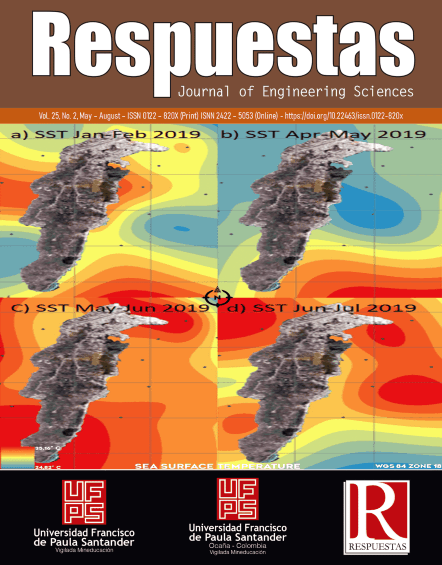Solar potential evaluation and political, economic and social analysis (PES) in the department Cesar – Colombia
Evaluación del potencial solar y análisis político, económico y social (PES) en el departamento del Cesar – Colombia
Main Article Content
This research shows the estimation of direct, diffuse and total irradiation in the department of Cesar (Colombia) through the use of the Bird and Hulstrom model and parameterizations of the Mächler and Iqbal model. The data used for this purpose were collected by the meteorological stations installed by the Institute of Hydrology, Meteorology and Environmental Studies of Colombia (IDEAM) corresponding to the range of collection and analysis with more than 20 years between 1993 and 2013, a period of study suitable for a comprehensive solarimetric study. Irradiation data were estimated taking into account four types of climate scenarios that depended on the type of atmosphere present in the study area. It was found that the solar potential of the department of Cesar, located on the Colombian Caribbean Coast, presents average total irradiations ranging from 6.2 kWh/m2day in very turbid atmospheres to 6.8 kWh/m2 day in extremely clean atmospheres, making it one of the regions with the highest irradiation values in Colombia. This panorama allows to visualize the great potential that exists in the region for the implementation of projects with both thermal and photovoltaic solar technologies. This study was also complemented with a political, economic and social analysis of Colombia compared to the United State to determine the improvement opportunities in Colombia.
Downloads
Article Details
J. Bosca, “Contribucion al estudio de la radiacion solar y de la determinacion de la turbiedad atmosferica. Aplicacion a Valencia y Sevilla.,” Universitat Politècnica de València, 1995.
A. Q. Malik, “A modified method of estimating Ångström’s turbidity coefficient for solar radiation models,” Renew. Energy, vol. 21, no. 3, pp. 537–552, 2000, doi: https://doi.org/10.1016/S0960-1481(00)00080-X.
J. Cañada, J. Pinazo, and J. Bosca, “Determination of Angstrom ’ s turbidity coefficient at Valencia,” Renew. Energy, vol. 3, no. 6–7, pp. 621–626, 1993, doi: 10.1016/0960-1481(93)90068-R.
A. Angstrom, “Determinig the Turbidity of the Atmosphere’,” Tellus XIII, 1961, [Online]. Available: https://onlinelibrary.wiley.com/doi/pdf/10.1111/j.2153-3490.1961.tb00078.x.
E. Villicaña, “Método de evaluación de la radiación solar por transmisibilidad atmosférica. Aplicación a la determinación del potencial energético solar de México,” Universidad de Oviedo, 2012.
M. Mächler, “Parameterization of solar irradiation under clear skies,” The University of British Columbia, 1983.
R. E. Bird and R. Hulstrom, “A simplified clear sky model for direct and diffuse insolation on horizontal surfaces,” Sol. Energy Res. Inst., 1981, [Online]. Available: https://www.nrel.gov/docs/legosti/old/761.pdf.
M. V. Chamorro and L. A. Viana, “Cuantificación y caracterización de la radiación solar en el departamento de La Guajira-Colombia mediante el cálculo de transmisibilidad atmosférica Quantification and characterization of solar radiation at the department of La Guajira-Colombia by calculating atmospheric transmissivity,” 2015.
A. J. Guti, P. Paredes-s, E. Villica, and J. Xiberta-bernat, “Solar energy potential in the coastal zone of the Gulf of Mexico,” vol. 81, pp. 534–542, 2015, doi: 10.1016/j.renene.2015.03.068.
A. J. Gutiérrez-trashorras, E. Villicaña-ortiz, E. Álvarez-álvarez, J. M. González-caballín, J. Xiberta-bernat, and M. J. Suarez-lópez, “Attenuation processes of solar radiation . Application to the quanti fi cation of direct and di ff use solar irradiances on horizontal surfaces in Mexico by means of an overall atmospheric transmittance,” Renew. Sustain. Energy Rev., vol. 81, no. July 2017, pp. 93–106, 2018, doi: 10.1016/j.rser.2017.07.042.
“ScienceDirect_articles_11Aug2020_05-40-54.” .
M. Iqbal, “Correlation of average diffuse and beam radiation with hours of bright sunshine,” Sol. Energy, vol. 23, no. 2, pp. 169–173, 1979, doi: https://doi.org/10.1016/0038-092X(79)90118-X.
M. Iqbal, An Introduction to Solar Radiation. 1983.
O. Pizano, Manual de climatización, Tomo II. España: Universidad Politécnica de Valencia, 1995.
IDEAM, “Atlas de Radiación Solar, Ultravioleta y Ozono de Colombia,” 2015. http://atlas.ideam.gov.co/visorAtlasRadiacion.html.
Q. Wang, S. Li, and Z. Pisarenko, “Heterogeneous effects of energy efficiency, oil price, environmental pressure, R&D investment, and policy on renewable energy -- evidence from the G20 countries,” Energy, vol. 209, p. 118322, 2020, doi: https://doi.org/10.1016/j.energy.2020.118322.
Z. Chen, J. Dong, and R. Ren, “Urban underground logistics system in China: Opportunities or challenges?,” Undergr. Sp., vol. 2, no. 3, pp. 195–208, 2017, doi: https://doi.org/10.1016/j.undsp.2017.08.002.
M. F. Zabaloy, M. Y. Recalde, and C. Guzowski, “Are energy efficiency policies for household context dependent? A comparative study of Brazil, Chile, Colombia and Uruguay,” Energy Res. Soc. Sci., vol. 52, pp. 41–54, 2019, doi: https://doi.org/10.1016/j.erss.2019.01.015.
C. Richter, S. Teske, and R. Short, Energía Solar Térmica de Concentración. Perspectiva mundial 2009. Greenpeace Internacional, SolarPACES, ESTELA, 2009.







